
You are reading the older HTML site
Positive Feedback
ISSUE
28
kr audio
Kronzilla DM amplifiers
as reviewed by Bradley Morrical
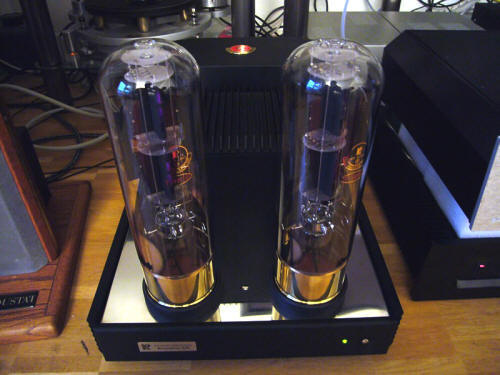
Images by David Kern
|
For many audiophiles, the KR Audio Electronics Kronzilla DM monoblock amplifiers will need no introduction. No other amplifier on the planet has tubes the size of these amplifiers, which makes them instantly recognizable. And of course there is the name, which evokes thoughts of a fire-breathing monster about to eat Tokyo (or your loudspeakers).
The Kronzillas, which have been around since 1999 in one form or another, were the last major amplifier design by Dr. Riccardo Kron, the founder of the company previously known as KR Enterprise. Kron died in 2002. His wife Eunice, who has been running the company ever since, hired some very talented engineers to push the company forward, and the product line has not stagnated. The DM monoblocks are second to the top-of-the-line DX monoblocks, which, at 100 watts per channel, have more than twice the power of the 45-watt DMs.
Positive Feedback Online has never published a review of a KR amplifier, so I contacted the company about doing one. Why should all the other web magazines have all the fun? Eunice thought this was a great idea, and put me in touch with KR's German distributor, Andreas Milkovits. It turned out that Andreas and Gerhard Brandl, maker of the stunningly beautiful Copulare equipment racks, were hosting an audition session/party in the heart of the Bavarian countryside about a month later. I don't live too far away, so Andreas invited me to take part in the fun, and promised to provide me with a review sample afterward.
That afternoon, I heard a system that totaled more than 200,000 Euro, consisting of a pair of Martin Logan Prodigies with a completely redesigned external crossover, a Martin Logan Descent subwoofer, two pairs of KR Kronzilla DMs with factory-authorized modifications, an Oracle turntable, and the top-of-the-line Esoteric CD system, which included the external clock and mono DACs. The CD system alone was around 70,000 Euro!! When I first heard the system, it had only been on for about ten minutes. I found the sound impressive, but a bit edgy and constricted. After all of the gear had warmed up, the sound became quite effortless, and began to show what the Kronzillas could do (although the bass integration was never perfect).
The next day, I visited Andreas at his home, and because he was not sure that the VA amplifiers would have enough power for my Acoustat Spectra 2200 or 1+1 loudspeakers, we decided that I should take a pair of the DM monoblocks. After a nice conversation about hi-fi and engineering (Andreas is an electrical engineer), I set off on the six-hour drive back to Zürich, eager to get the beasts (which weigh about 60 kg apiece in their wooden crates and 37 kg unboxed) up the stairs and into my system. At the time, I couldn't have imagined how difficult it would be to get them out of my system!!
The construction and finish of the Kronzilla DMs is beyond fault, and fully in line with their over-$20K asking price. Make what you will of their appearance, which is somewhat industrial. Some of my visitors have found them over the top, but I do not agree. In my opinion, they have a serene majesty. After my guests got over the initial shock of seeing the amps, many commented about how beautiful they looked. I think that the output tubes are 99 percent responsible for this. The huge T1610 tubes (two per amplifier) are works of art by themselves, and if, like me, you appreciate fine mechanical work, you will marvel at their construction.
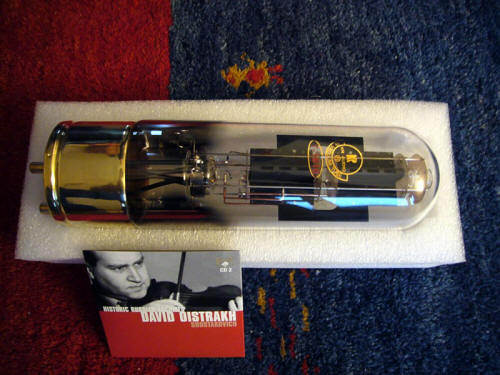
The Kronzillas are massive, with each having two very large transformers—one for power duties and the other for output. Front and center are the massive tube sockets. While the tubes fit snugly into the sockets, I still felt a bit uneasy about the fact that they stand freely. It would be nice if the sockets had some kind of locking device, as the tubes could easily be bumped out of position. They never were, but accidents can happen. There is an optional cage of sorts, called the Butterfly, which not only puts some metal between you and the tubes, but aids in the dissipation of heat.
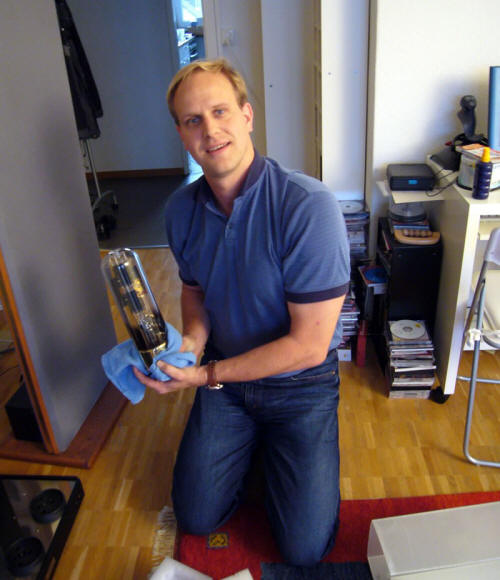
KR designs and makes their tubes in house, by hand. They utilize novel concepts of tube construction, including ribbon filaments, hard glass envelopes, and extremely low pressure (or high vacuum) inside the tube for long life. The build quality of these tubes is superior to that of any others on the market, although strictly speaking, I can't say this about the T1610s because no one else is making tubes like them. After noticing the gigantic output tubes, the next thing one notices about these amplifiers is the absence of other tubes. Normally, the top deck of a high-end tube amp is covered with a plethora of tubes, including an input tube or two, some driver tubes, and one or more rectifier tubes (some of the Kondo amps have four rectifiers!).
The Kronzillas have none of these. Earlier KR amplifiers used specially designed small-signal tubes for voltage gain, but not the Kronzillas. Under the skin of a Kronzilla beats an all-solid-state heart. Yep, that's right—the Kronzilla is a reverse hybrid design. I only know of a few other amplifiers that have taken this approach—the Music Reference RM-200 (still available), which uses a tube driver stage, and the Audio Research Classic and M series amplifiers, although in these, I believe that only the input stage was solid state. The Kronzilla uses tubes only at the output stage, which means that both the voltage gain stage and the high-voltage driver stage utilize FET transistors. As I say, it is not unheard of for the input stage of an amplifier to be solid state, but a MOSFET used to drive an output tube must be capable of very high voltages swings, and this is an unusual task for a transistor. Still, such high-voltage devices do exist, and the Kronzilla makes good use of them.
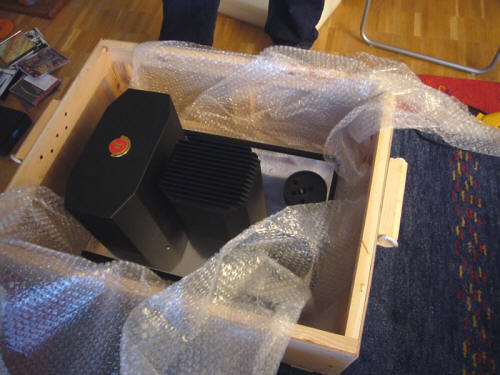
Since the amp runs in pure Class A, it gets quite hot after being on for an hour or so. The sides of the amps have shallow heat sinks, which I thought were purely cosmetic at first because I assumed that most of the heat would be coming from the output tubes. When I touched the sides of the amps after they had been on a while, they were pretty hot! That made me realize that the heat sinks were dissipating the heat of the driver transistors and input stages. Finally, although each amp sports two output tubes, they are not push-pull amps but parallel SET hybrids with no negative feedback, which may make them unique in the world of amplifier design. If someone knows of another amplifier designed like this, please send me an email and let me know.
Andreas told me that because the amplifiers were new, they would need about forty hours of break-in time, so I put them in my system and left them running for a couple of days. I did not listen to them during this time, so I have no idea if the sound changed appreciably. I can say that it hasn't done so since I began listening to the amps, which suggests that break-in is not a huge concern.
What I got upon first listen was a shock of the most pleasant kind. The Kronzillas simply sounded incredible. I heard transparency right to the back of the hall, spot-on tonal balance, great bass control, and most interestingly, intense dynamic contrasts—all of this coming from 45 watt SET amps driving speakers (my Acoustat Spectra 2200s) that drop to 2 ohms in the bass! Their control of the Acoustat 1+1s (which only drop to about 3 or 4 ohms) was even better. These are not your grandfather's SET amps, but different beasts altogether. They have the dynamics and grip that this genre of amplifier is simply not supposed to have. Their tonal balance does not have the warm and fuzzy character that gives SETs a bad reputation in some circles. They seem to walk a tightrope between warm and cool. They are just right, and seem to be telling you exactly what is on the recording.
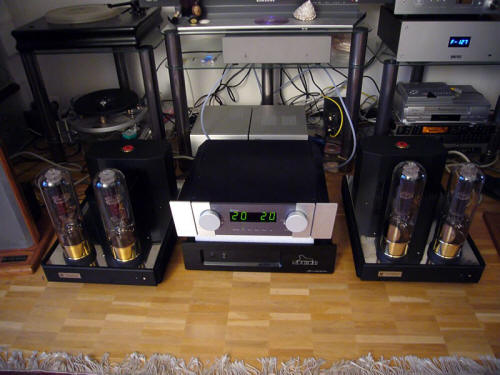
The resolution is simply world class, on the level with that of the best OTL amps I have heard. Although the Kronzillas let you hear all of the transient details of the music, they don't stop there, because you can also hear the full harmonic bloom of the instruments and their VERY long decay. What is more, these elements emerge within a truly natural perspective—they never run over each another and smear the sound. Hall ambience and acoustic echoes are not only easily heard, but are rendered quite separately from the main sounds. In my experience, only very few amplifiers can walk the kind of line I am attempting to describe. Most fall to one side or the other, either highly analytical or richly harmonic.
The analytical amplifier is often lacking in harmonic structure (i.e., correct timbre) and decay. It resolves to the back of the hall because it gives only a skeletal picture of the music. Instruments are separated in space but not tonally differentiated, and the ultimate effect sounds a bit clinical and cold. On the other side of the line is a sound that is more enticing to many experienced listeners. It is a bit warm (some say "musical"), full of harmonics, and often a bit fat and loose in the bass. Amplifiers that fall into this trap simply trade one type of distortion for another, and the price paid is a lack of the precision that cannot be heard at live, unamplified concerts. This warmth is created by distortion in the low frequencies, and by harmonic smearing, which limits resolution and diminishes clarity when the music gets complicated. Instruments blend together and lose their individuality. With relatively simple music, this kind of sound can be satisfying—at least for a while—but ultimately, the uniformity of sound that these amplifiers create, with all kinds of music, can lead to boredom, or a swing to the other side of the sonic fence.
My point in all of this is that the KR Kronzillas have all of the speed, resolution, and bass control of the best solid state or OTL amps, but retain the tonal and spatial accomplishment of good tube amps, along with a dynamic drive and energy that I haven't heard from any other amplifiers. The origins of their technology are not at all obvious from listening to them. In my opinion, they realize the ideal of the hybrid concept, and have done so in exactly the reverse manner from which I would have expected it to come.
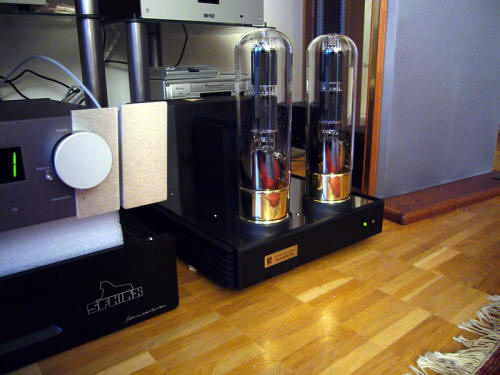
On to music. When I listened to Beethoven's Eroica symphony conducted by Nicholas Harnoncourt on Teldec, I heard an incredible amount of acoustic information with (as near as I could tell) strong harmonic integrity. The spatial placement of instruments was spot on, and rock solid regardless of the dynamics. The impact from tympanis and horns was dramatic. Tonal color seemed to be just right—neither warm nor cold. The swings from soft to loud were breathtaking, and subtle shifts in microdynamics (an SET specialty) came through like I was sitting next to the performers.
My copy of Prokofiev's Romeo and Juliet, performed by the Ukranian Radio and Television Orchestra and recorded by freelance recording engineer Russell Dawkins, is another big work that can push an amplifier's resolving capabilities to the limit as well as demonstrating its abilities with respect to instrumental timbre and spatial resolution. This recording is unique in that it was made direct to DAT using a single stereo ribbon microphone. The full dynamics of the orchestra were captured without compression or limiting. The recording has a great sense of acoustic space, wonderful tone, and full-range dynamics. How did the Kronzillas handle this demanding recording? Up to the clipping point (I could make the amps clip, but only rarely), they performed extremely well indeed. The separation of instruments was superb, and again, tonality was correct. The resolution was such that I could hear the individual bowings of massed violins and double basses. Horns had the bloom one hears live, and the back of the hall was clearly decoded. I felt as if I had been transported to the concert hall.
A relatively new (to me) five-LP box set is Wagner's Die Valkyrie on Decca Royal Sound Stereo, conducted by Georg Solti and performed by the Vienna Philharmonic Orchestra along with some of the best operatic singers from the late 1960s. Opera is not normally my kind of music—in fact, it is one of the few musical genres not to my liking—but according to my web searches, this is considered to be the finest recording of Die Valkyrie ever made. According to an associate who is an avid record connoisseur, it is one of the finest opera recordings ever made. I can certainly report that it demonstrates the incredible resolving power of the Kronzillas and of my new turntable/tonearm combo. One of the admirable traits of this LP box set is that big crescendos never distort or compress. They simply keep expanding, and this is something that is not at all common for orchestral LPs (and is one of the main advantages of CDs over LPs). The most startling thing about this recording is how well the voices are captured. Their character, tonal qualities, presence, modulation, location on the soundstage, and even the direction the singers are facing, are all beautifully preserved. With the Kronzillas, all of the words were clearly enunciated, and the dynamics were shockingly real. With my Sphinx amplifier, everything gets a bit softer and less distinct, and dynamics are decidedly less involving.
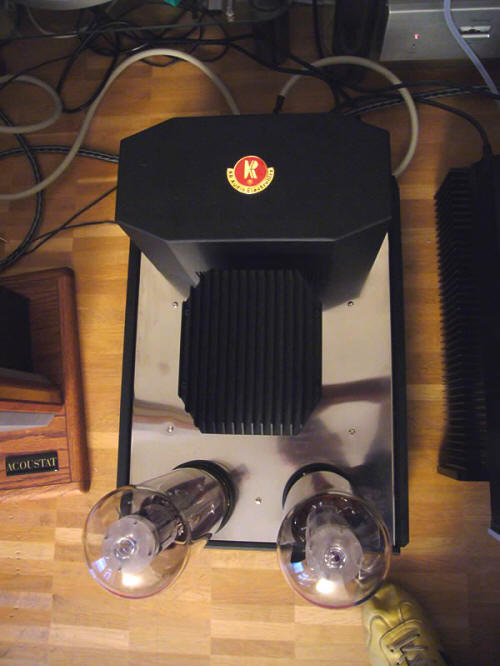
What about some jazz, you say? One of my favorites is an ECM recording of Chick Corea on piano and Gary Burton on vibraphone, recorded live in Zürich in 1979. The recording, of just the two musicians, has some of the most beautiful tone (from the vibraphone especially) and jumping dynamics I have heard from any jazz LP. The playing is also on a level that regularly leaves my jaw hanging. With the Kronzillas, the initial attack of a note on the vibraphone, a kind of pre-resonance, the full bloom of that note, and then the decay, were all captured. This was true for every note, even during blindingly fast runs. Notes never blurred or smeared. The full dynamics and subtle shading of the instrument were brought to light in ways I had never heard, in my or precious few other systems. Chick Corea's piano was also captured with full tone, down to the lowest notes, and with dynamics that were reminiscent of the real thing.
My Sphinx amp, which until then had done an admirable job keeping up with some of the top-flight amplification I'd compared it to, was woefully outclassed by the Kronzillas. Of course, this should be the case in light of the price difference (if still made, the Sphinx would be about one third of the price of the Kronzillas), but I had always thought that the Sphinx was one of the better amps I'd heard that sold for less than $10,000. Even compared to the sonic fireworks of the Silvaweld Tube Reference OTLs and the superb clarity of the AcousticPlan Santor, the Sphinx was never far behind, and in many respects it was equal or slightly ahead. Not so with the Kronzillas. The only area in which the Sphinx remained competitive was tonality, but compared to the Kronzillas, the Sphinx sounds slightly too romantic.
What about the AcousticPlan Santor, an amp that I had previously regarded with fondness, and is, without doubt, a fine amp? I didn't have it on hand for comparison, but I think I can say that the Santor is nearly equal to the Kronzillas in low-level resolution (quite impressive for a push-pull amp), and that it has a very similar tonal balance, although it is slightly on the leaner side of the line. In my opinion, the Kronzilla defines the line for correct tonal balance. The Santor is closer to this ideal than the Sphinx or my Silvaweld OTLs, but falls decisively behind the Kronzillas in dynamics. The Santor's dynamics are similar to the Sphinx's, which is to say that by comparison to the Kronzillas, it sounds a bit squashed. It must be kept in mind, though, that the Santor is only about a quarter of the price of the Kronzillas, and remains one of the best amps I have heard in its price class. Only the Silvaweld OTL monoblocks were comparable to the Kronzillas in terms of sheer dynamics, but with them, this seemed more a parlor trick than a part of an integrated whole. Why? There are two main reasons:
The first is that the Silvawelds' microdynamics and low-level resolution are simply not as good as those of the Kronzillas. When a big dynamic swing come along, the Silvawelds sound somewhat discontinuous. With the KRs, it builds and explodes more naturally, like a big wave breaking rather than a bomb going off. Instead of an abrupt shock, I have a clear sight of what is coming. In a way, this makes the Silvawelds more exciting, but with extended listening, I came to realize that in softer passages, I was not getting the same kind of microdynamic variations that the Kronzillas provide, and that because of this, the Silvawelds create a disconnection between micro- and macrodynamics. Although the Silvawelds are not crude amplifiers by any means, they lack the subtlety of the Kronzillas.
Second, the Silvawelds lack the bass control of the Kronzillas. Although their dynamics are dramatic and exciting, they are also a bit sloppy. Watching the Silvawelds' DC offset meters was instructive in understanding why the amps would lose their grip on the bass during large transients. When big peaks came along (identified by the total current meters on the amps), the DC offset meters pulled slightly to the left or the right, indicating an imbalance in the two sections of the SEPP output stage due to dynamic differences in the bias on the output tubes. I suspect that this imbalance is largely responsible for the flabby bass on big peaks, as it signifies that the tubes are no longer working perfectly together.
The Silvawelds are slightly warmer, with great midrange presence and beautiful highs. While not as strictly neutral as the Kronzillas, the Silvawelds are quite bewitching, with a bit more of that "inner glow." Their imaging and soundstaging are world class, equal yet slightly different from those of the Kronzillas. Overall, the Silvawelds are close to the KRs in several ways, but not nearly as well rounded. They are more one- (or two-) trick ponies than the Kronzillas, which present a complete picture. Still, based on their last retail price (about 9000 Euro), the Silvaweld OTL monoblocks are almost underpriced.
To date, the only amp I have heard at home that I believe can give the Kronzillas a run for the money are the similarly-priced Vacuumstate DPA300Bs, which sell for about 14,000 Euro. However, the DPA300Bs are only 18 watts per channel, and while they work fine with my Acoustat 1+1s, they simply can't get the job done on the Acoustat Spectra 2200s. For easier-to-drive speakers, though, I hear many of the same qualities I hear from the Kronzillas. Which is the better amp? At this point I cannot give a decisive answer to that question. On the Spectra speakers; however, it is undoubtedly the Kronzillas.
In addition to trying the Kronzillas with my two different pairs of electrostats, I was able to hear them with several other speakers. These included the new Piega TC70xs, which use a unique coaxial planar magnetic driver, the Wilson Benesch Curves, the Relco Mantis ribbon hybrids, and finally a pair of the original Wilson Audio X1 Grand SLAMMs. Also present at the demo with the Piega, Wilson Benesch, and Relco speakers was an ASR Emitter I Exclusive "integrated" amplifier. With the Piegas, the Kronzillas generated a huge soundstage with great transparency and drive, but the Wilson Benesch speakers were not to everyone's taste, sounding somewhat incoherent and colored. The best sound at that session came from the Relcos. These speakers have Apogee-like ribbons mounted above sealed box woofers. The bass doesn't go very deep, but it's quick, tight, and punchy, and it can keep up with the ribbons. These speakers sounded simply stunning with the Kronzillas, with a huge, wide-open, and totally transparent soundstage. Dynamics were far greater than we thought possible with these speakers. All of the other listeners were as deeply impressed as I was.
What about the ASR Emitter I Exclusive? I realize that its big brother, the Emitter II Exclusive, is the current darling of a few big-name reviewers, but in this listening session, it didn't stand a chance against the Kronzillas. With the ASR amp, the soundstage shrunk, the dynamics flattened out, as did the soundstage depth, and the tonal color turned somewhat gray. I have since been told that this Emitter had only been on for a few days, and that its sound has greatly improved. Apparently, the Emitter, with its huge power supplies, needs quite a long time to reach its potential, but at this listening session, the gap between the ASR and the Kronzillas was pretty close to the Grand Canyon. One listener swore that the Emitter was broken. This was not a joke, because this was a serious guy (he owned the Piegas), and the sonic differences left him shaking his head and muttering to himself in bewilderment.
When I hauled the KR amps over to the house of the friend who owns the Wilson X1s, we were treated to the best sound I have ever heard from Wilson loudspeakers. Since the X1s are highly sensitive and an easy load, I expected good sound at the very least, but what we heard was hard to describe. The bass control on Kodo drums was utterly shocking. We kept looking at each other with stupid grins throughout the listening session. Soundstaging and transparency were simply holographic. Until then, I had never heard Wilsons sound like that, and had always been thoroughly underwhelmed by them. Not anymore. The combination of the X1s and the Kronzillas was one of the best speaker/amp combos I have heard. I had no idea the X1s could sound that good.
The KR Audio Electronics Kronzilla DM monoblock amplifiers are world class in every respect. I hear no real weaknesses in any aspect of reproduction, especially in the areas that most SET amps are considered weak, like bass control. I tried them with a variety of speakers, from very easy to drive (the Wilsons) to very difficult (my Spectra 2200s), and on every occasion, the Kronzillas delivered dynamics, control, transparency, and tone par excellence.
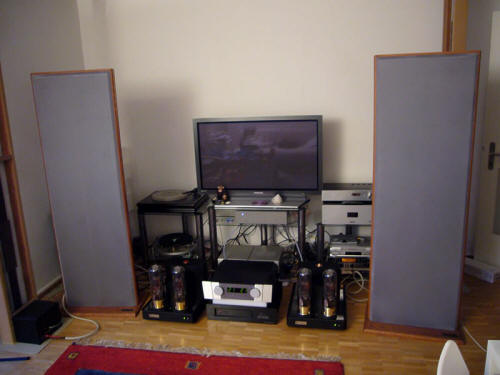
Those of you who have read my reviews know that I can be quite critical, and that I don't hesitate to mark down pieces of gear for small offenses, but I can honestly say that for the first time, the KR Kronzillas have me seriously considering robbing a bank to buy them. It saddens me to think that they are not going to be in my system anymore, as they are by far the finest amplifiers that I have lived with for any length of time. I suspect that few (if any) other amplifiers can beat them, let alone equal them. I am not kidding. I haven't hooked up my Sphinx for the last three weeks, as I have absolutely no desire to use it while the Kronzillas are around. The poor Sphinx has never been quiet this long unless I was on holiday, but it has been silenced by a pair of amplifiers that are far superior in nearly every meaningful way, including the intangibles of musicality and involvement in the music. I will be sending them back for now, but I will be saving my pennies so that I can eventually own the very best amplification I have ever heard.
That is not to say that the Kronzillas don't have competition. The Vacuumstate DPA 300Bs could be a serious threat with reasonably sensitive speakers. So could one of the Joule Electra OTLs, or perhaps the Lamm ML2.1s. I have heard these amplifiers at one time or another, but not at great length, so my judgment will have to wait. Also at the most expensive end of the spectrum are the likes of Jadis, Kondo, Shindo, Wavac, etc. I have heard examples of all these extremely high-priced marques, and I think that the Kronzillas have the measure of all of them. I will leave it at this: The Kronzilla DMs are my desert-island amplifiers. While expensive, they deliver the musical goods unlike any other amps I have heard. My only question now is whether the 100-watt DXs are better. Double the power and an extra 3dB of headroom sure would be nice for difficult speakers like my Spectras, although the DMs rarely ran into problems. If you have deep pockets and want the very best sound, you must hear the KR Kronzillas! Bradley Morrical
KR Audio
web address:
www.kraudioproducts.com
